Revival festivals like Il Cinema Ritrovato drive home the importance of funding for and preservation of the arts. Long live feminist cinema rediscovered!
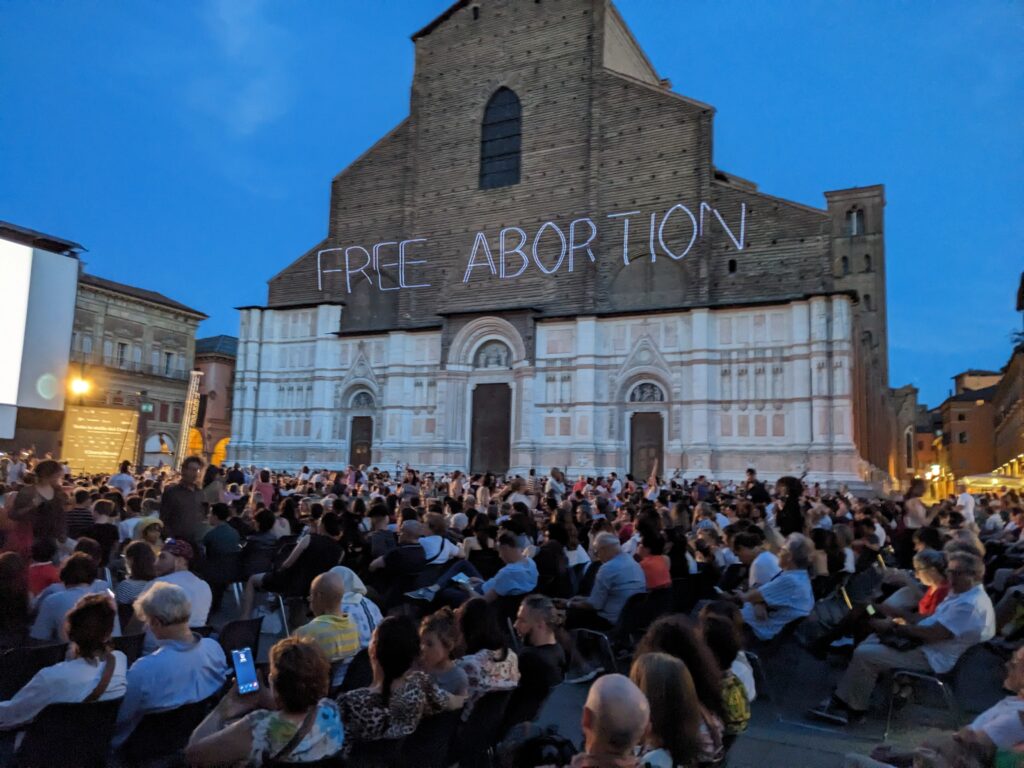
Three thousand cinephiles congregated at dusk in the Piazza Maggiore in Bologna, Italy, on June 27 for an outdoor cine-concert of The Wind (1928)—a silent film about desperate love in bad weather—with the message “FREE ABORTION” projected on a church at the side of the square. The people hummed in euphoric anticipation. But they were not alone. Lesbian vampires, cross-dressing gun slingers, communist sex workers, feminist cinematographers and a woman whose bad date literally turns out to be Satan—these hell-raising dissidents all had pride of place in the feminist programming at Il Cinema Ritrovato.
The annual archival film festival draws thousands of spectators from all over the world to Bologna every June. The Ritrovato’s rallying cry is to spotlight long unseen, unjustly forgotten but urgently timely works from the celluloid archive and unleash them onto the volatile, open-ended present. A pride parade, reproductive rights activism and pro-Palestine student protests intersected with a nine-day festival whose programming ranged from Japanese costume dramas and Napoléon biopics to Algerian feminist essay films, 16mm queer body poems, and “second wave exploitation” comedies about utopian-socialist polygamy.
This year’s 38th edition featured 480 films produced in 35 countries from 140 archives—some as short as several minutes, such as the early feminist thriller A Wife’s Revenge (1904) in which an aggrieved spouse murders a male duelist with her dead husband’s sword.
Other screenings assert their own bodily rhythm and sensation of time, exemplified by Marva Nabili’s Khak-e Sar bé Mohr. [The Sealed Soil] (1977), a Brechtian depiction of a laboring woman’s defiant refusal of compulsory marriage that Nabili filmed secretly in Iran (where it was never screened) and then edited in the U.S. The film circulated on bootleg VHS tapes until UCLA Film & Television Archive “brought it back from the grave”—a frequent refrain for the photochemical alchemy exercised on thousands of decaying reels that barely survived the ravages of their misplaced capitalist exchange value.
The Ritrovato is nothing less than a celebration of the capacity to create community around films that you quite literally could not see anywhere else—long obliterated from the archive due to a combination of material decay, political censorship and ideological incomprehension. I was especially struck this year by the feminist themes that emerged across the festival’s heterogeneous programming.
Changes in film are reflections of what will happen on the planet. Otherwise, there won’t be a planet.
Ellen Burstyn
It is a cliché to say that we are haunted by the specter of 1968. Neo-colonial domination, breakneck social inequality and world-ending planetary catastrophe add fuel to the flame of revolutionary social uprisings and collective political organizing. Unfinished, unseen and unrealized feminist films of the 1960s and ’70s spoke directly to the present zeitgeist. Their message: What you see is not a test!
As Ellen Burstyn put it, “Changes in film are reflections of what will happen on the planet. Otherwise, there won’t be a planet.” Burstyn’s words punctuate a haunting final close-up of Sois Belle Et Tais-Toi! [Be Pretty and Shut Up!] (1976), produced by Les Insoumuses (The Defiant Muses), a French feminist video collective that deployed lightweight cameras as “tools of emancipation and means of political activism,” according to the curator Émilie Cauquy.

Be Pretty and Shut Up! is a cheeky title for a talking head documentary. Formative to the 1985 Bechdel test, Delphine Seyrig interviews 23 female actors about their routine indignity of being a woman in cinema.
Jane Fonda coolly recounted how Jack Warner forced her to wear fake breasts: He “made it very clear that I was a commercial product.”
Viva (of Warhol’s 1969 “porno chic” Blue Movie) mocked the lazy writing that propels infantilizing typecasting: “You have the body of a 40-year-old woman but inside it’s like you’re a 2-year-old,” Viva remarked. “That’s what makes it grotesque.” The need for more opportunities for women behind-the-scenes—as directors, writers, grips, camera operators, editors and producers—looms large as a vital refrain, because “an actress is someone who works in a lot of other people’s productions,” as Viva defined it.
Seyrig was herself an actor (and activist), though she preferred to work in a lot of films made by women, such as Ulrike Ottinger, Marguerite Duras and Chantal Akerman. For those not familiar, Akerman’s opus Jeanne Dielman, 23 Quai Du Commerce, 1080 Bruxelles (1975) was recently voted the “Greatest Film of All Time” in the BFI’s Sight and Sound poll. Jeanne Dielman follows Seyrig as an alienated sex worker who pounds veal cutlets by day and eventually murders her john. Strikingly, it was not included in “Just Another Sorceress,” the festival’s round-up of six films with and by Seyrig, which prioritized long inaccessible and wrongly excluded works—from Sois Belle (newly restored from a “badly damaged” print thanks to the Simone de Beauvoir Centre) to Akerman’s uncanny musical comedy Golden Eighties (1986) to Babette Mangolte’s completion of Seyrig’s own aborted 1980s film project, Calamity Jane and Delphine Seyrig: A Story (2019).
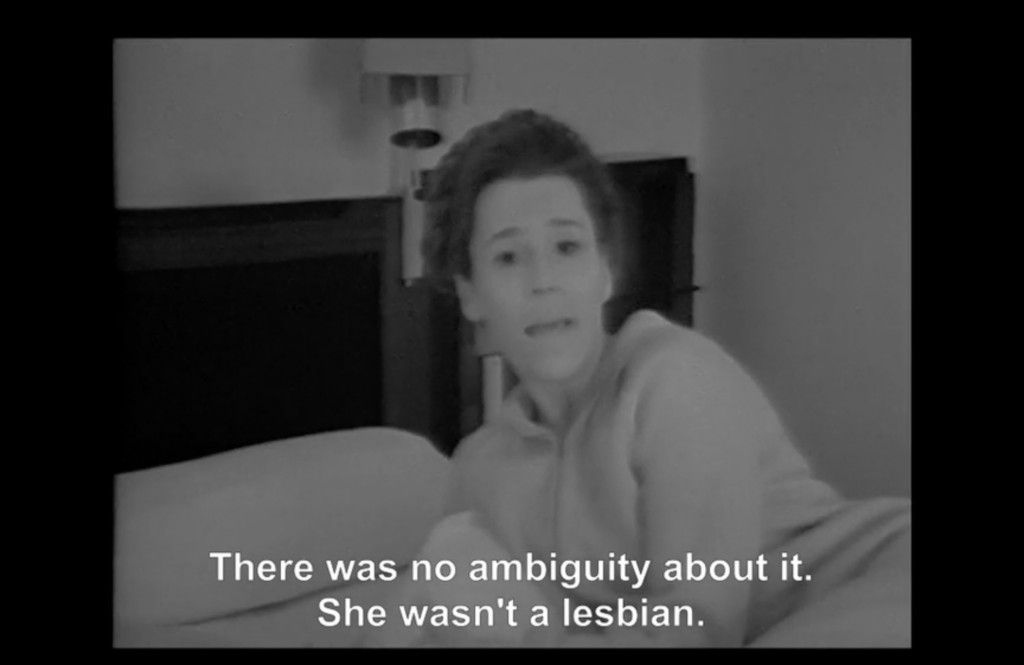
Mangolte reigned as a preferred cinematographer for feminist avant-garde filmmakers including Akerman, Sally Potter, Yvonne Rainer and Jackie Raynal. But she herself never became a director until 2019. As she explained in her introduction to Calamity Jane: “You could not avoid to be a filmmaker and a feminist when Donald Trump is the president.”
Seyrig (who died in 1990) had been obsessed with the bull-whacking, booze-drinking, cross-dressing sharpshooter Mary “Calamity” Jane Canary, so she brought Mangolte to Montana with her in 1983 to film 16mm interviews in preparation for a dramatization of Calamity’s journals and personal letters to her daughter. Seyrig hoped to direct the film and star as Calamity with potential funding from the CNC brokered by Akerman. Unfortunately, the CNC pulled out and the footage was shelved for decades to collect dust. Mangolte’s film unearths Seyrig’s fascinating interviews with Calamity biographer Stella Foote, who lounges in a pool in her bright fuchsia bathing suit while Seyrig poses incisive questions from offscreen—decked out in a sleek dress suit, high heels and dark sunglasses.
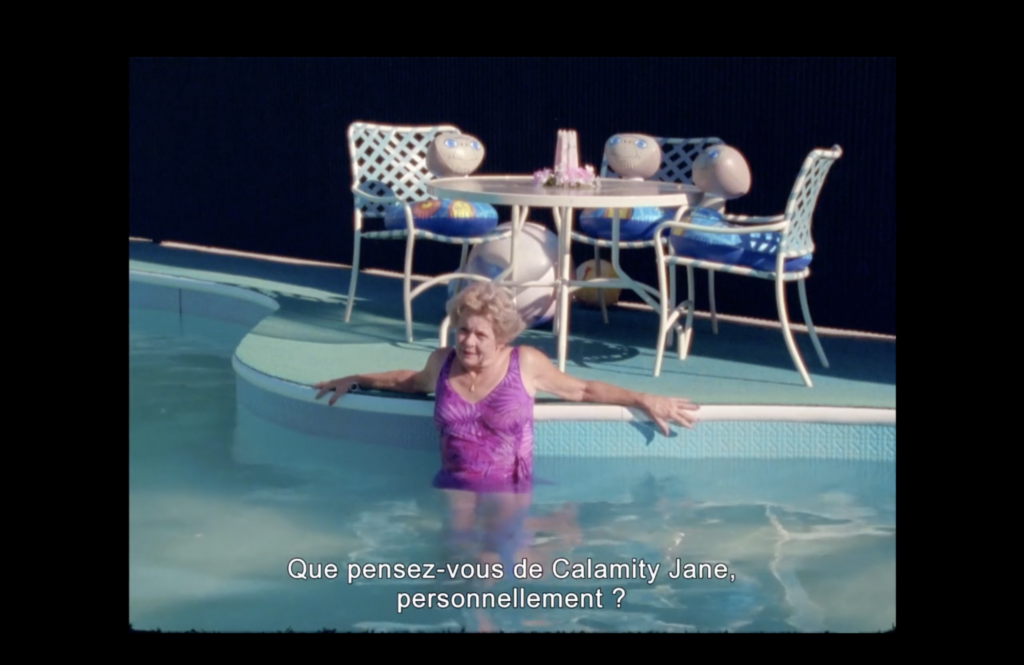
Seyrig had read about Calamity in a booklet “illegally” published by the Shameless Hussy Press, which Foote swiftly sued for copyright infringement. “She’s what I would call the first woman lib,” said Foote, because “she did things in those days that only men were supposed to do.”
It is no secret why Seyrig identified with the story of Calamity. Rather than lament what could have been, Mangolte opens her own film with a call for wayward speculative historical imagination. She interviews the feminist scholar JJ Wilson—posed next to a beautiful display of Ursula K. Le Guin novels—who refers to Calamity as an “outlier” instead of a “trailblazer,” given all its settler colonial baggage. Like Mangolte and Seyrig, Wilson looks to Calamity for her capacity to inspire myth. “In these myths,” explained Wilson with a bemused smile, “I was finding more truth than in libraries.”
What difference would it make or have made if Seyrig had been able to finish her own film? She “could have been a great filmmaker,” said Mangolte in her Bologna introduction, and she “was a great filmmaker in what she managed to do.” Documentaries that blow open the unresolved feminist archive give renewed immediacy to the Ritrovato’s microcosm of niche cinephilia, “searching out the feminist possibilities of incompletion,” to quote Alix Beeston and Stefan Solomon’s Incomplete manifesto.
The scene of archival incompletion becomes a springboard for cinematic writing in Céline Ruivo’s new documentary, Cinégraphies, Les Femmes de la Tempête [Women of the Storm] (2023), which she presented in Bologna. Haunted by the closing shot of Maya Deren’s Ritual in Transfigured Time (1946), Ruivo interviews three NYC-based experimental filmmakers who have been active since the 1970s—Peggy Ahwesh, Jeanne Liotta and Su Friedrich—“curious to find points of junction” between their distinct styles and Deren’s unfinished legacy.
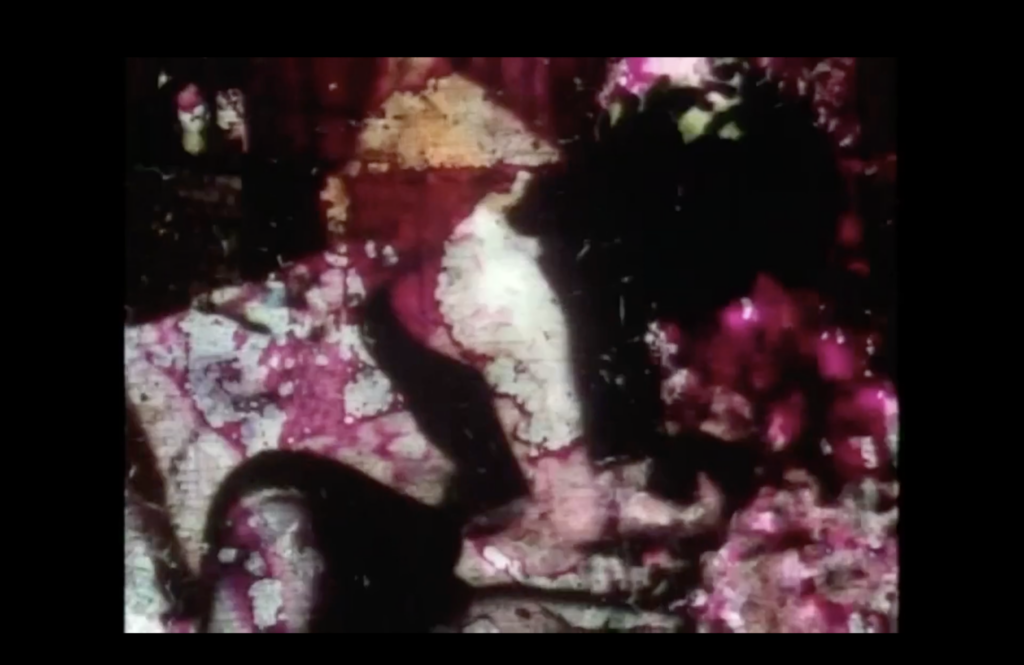
At the end of Ritual, a woman (played by Deren) sinks into her “astronomical coffin,” “attracted by the force of gravity,” and then “looks straight ahead.” Her unveiled image dissolves into an uncanny photochemical negative, which serves as a metaphor for “a place of writing” where “breathing no longer exists.” Ruivo’s breathless study pulses with enigmatic frames that pose a broader riddle of feminist writing in images. The answer to the riddle boils down to the afterlife of the film stock, graphically illustrated by Ahwesh’s optically reprinted 70s porno The Color of Love (1994), which screened later in the festival in a queer “small gauges” program. Ahwesh repurposed 8mm film stock that had suffered bad water damage, as she explains to Ruivo, transmogrifying those soggy reels into a kaleidoscopic explosion of “crazy purple and red colors that I could never have imagined.” It evokes what Jennifer Bean elsewhere calls cinema’s vital decay—the play of light and shadow that unleashes its wrongly foreclosed social possibilities.
Most of the film archive did not survive. Like Jane Fonda’s body parts (as per Jack Warner), its costly reconstruction is reduced to a crude “commercial product.” Revival festivals drive home the massive importance of funding for the arts beyond its commodity imperative—for film preservation, evocative curation and collective exhibition. “The significance of culture is to give people the strength to intervene in politics,” as Amílcar Cabral affirms in a documentary of Cape Verde’s carnival festivities during its first years of independence from Portugal.
Spotlighted in the “Cinemalibero” section—which chronicles African, Middle Eastern, Southeast Asian and Latin American political cinemas systematically excluded from the canon—Sarah Maldoror filmed her carnival trilogy as a celebration of “resistance and liberation from colonial domination,” wrote the curator Cecilia Cenciarelli. Larger than life parade floats, zoomorphic party masks and papier-mâché caricatures announce the dialectical collision between Maldoror’s playful aesthetics and cinema’s pan-African politics.
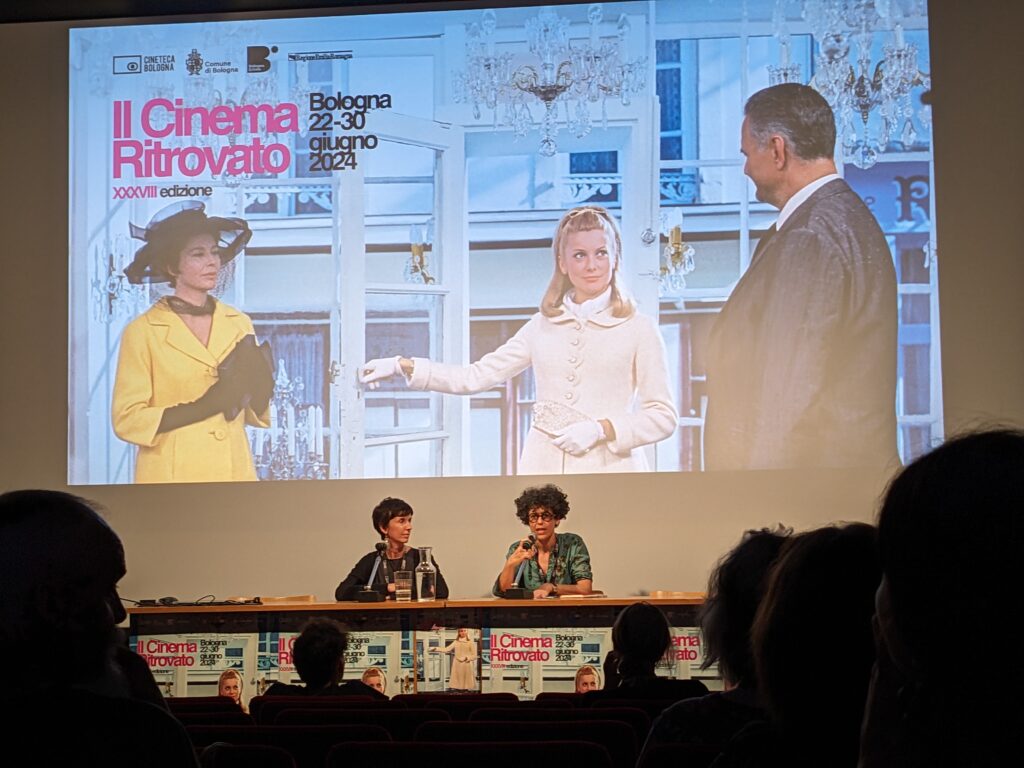
On a differently light note (but no less consequential), I rounded out my reactivated time capsule with a feminist trifecta of “second wave exploitation” comedies. Visions of socialist sex work, utopian polycules, pre-legalized gay marriage and equal rights nudity provoked howling explosions of laughter in Bologna’s Europa Cinema, which reprised two of Rothman’s entendre-laden masterpieces: Group Marriage (1972) and The Working Girls (1974).
All the original negatives of both films had been lost, so MoMA archivist Dave Kehr had to salvage Rothman’s personal copies, color grading them frame-by-frame—with a third restoration of the “sex slave” thriller-satireTerminal Island (1973) underway. Rothman (who worked with Roger Corman) directed only seven films until funding ran dry and she pivoted to a fruitful career in commercial real estate. The Working Girls was her last film, which appropriately ends with a message of collective worker ownership.
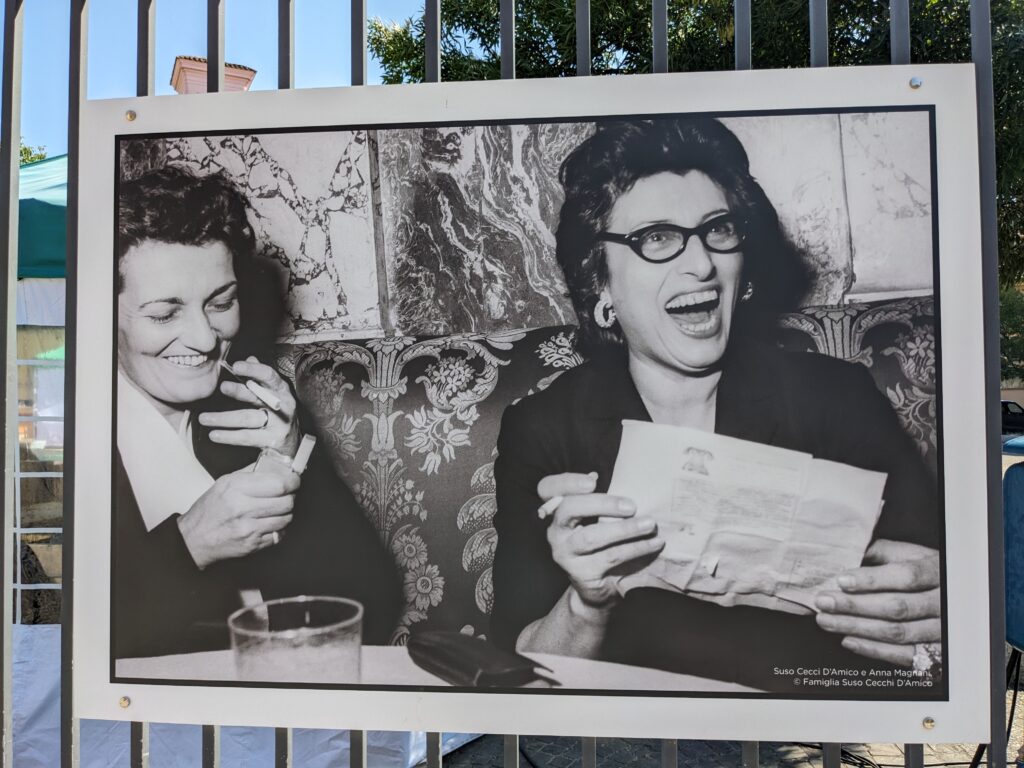
Rothman described her transgressive films as “vehicles for ideas” and self-identified as a “natural born clown.” As long as they contained “ample nudity” and “conventionally attractive” performers, “I could pretty much do whatever I wanted,” Rothman reflected in a festival session.
In a similar spirit, Czech costume designer and screenwriter Ester Krumbachová’s Vražda Ing. Čerta [The Murder of the Devil] (1970) gleefully lambastes the cannibalistic appetites of the patriarchy in an absurdist fever dream that teems with equal parts libidinal mischief and regurgitated food porn. Murder’s premise is irresistible: An erotically voracious woman is forced to confront the dawning realization that her textbook bad date is literally the devil. It was the only film Krumbachová ever directed.
We need comedy more than ever now in 2024. As the crises of the 20th century congeal into the dystopian present—à la resurgent fascism, brutal exploitation, war, sexism, racism and planetary catastrophe—it will be that sweet spot between irreverent humor and inescapable violence that breathes new life into our disenchanted souls. Long live feminist cinema rediscovered!
Up next:
U.S. democracy is at a dangerous inflection point—from the demise of abortion rights, to a lack of pay equity and parental leave, to skyrocketing maternal mortality, and attacks on trans health. Left unchecked, these crises will lead to wider gaps in political participation and representation. For 50 years, Ms. has been forging feminist journalism—reporting, rebelling and truth-telling from the front-lines, championing the Equal Rights Amendment, and centering the stories of those most impacted. With all that’s at stake for equality, we are redoubling our commitment for the next 50 years. In turn, we need your help, Support Ms. today with a donation—any amount that is meaningful to you. For as little as $5 each month, you’ll receive the print magazine along with our e-newsletters, action alerts, and invitations to Ms. Studios events and podcasts. We are grateful for your loyalty and ferocity.





